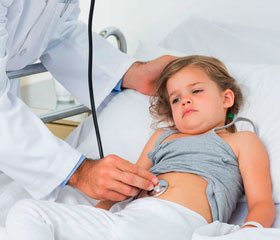Журнал «Здоровье ребенка» (62) 2015. Тематический выпуск "Детская гастроэнтерология"
Вернуться к номеру
The issue of intestinal complications early diagnosis antibiotic therapy of children
Авторы: Radutna O.A., Ivanko O.G., Kysyma N.V., Krut O.S. — Zaporizhzhia State Medical University
Рубрики: Педиатрия/Неонатология
Разделы: Клинические исследования
Версия для печати
Ключевые слова
antibiotic-associated diarrhea, toxins, children.
One of the widespread intestinal complications antibiotic treatment of children and adults is "antibiotic-associated diarrhea" (AAD). According to research, the most important etiological factor which causes to 90% of the AAD and colitis is an infection Clostridium difficile.
Diagnosis of Clostridium difficile-associated diseases is based on a comprehensive assessment of anamnestic, clinical and laboratory data. In Ukraine Clostridium difficile-infection was poorly assessed in view of the fact that laboratory diagnosis effective methods were not implemented.
Purpose of research - to improve intestinal complications timely diagnosis of antibiotic therapy caused by Clostridium difficile infection of children.
It was examined 131 children in age from 6 months to 18 years. Among them 116 suffered from bacterial and inflammatory diseases and needed antibiotics treatment. Patients were divided into two groups: 84 children are acutely got sick and required prolonged antibiotic therapy and 32 children with recurrent diarrhea syndrome.
According to a survey of 84 children from the first group who corresponded the requirements of involvement in research and received antibiotic therapy for acute somatic pathology in hospital, the acute AAD detected in 21 children (25%). Of these children 76% had diarrhea associated with Clostridium difficile toxins appearance in faeces. The other 24% of patients had idiopathic diarrhea (non-specific).
It was determined that patients with AAD were more common among those who received three or more antibiotics courses (53% versus 27% of patients), (pt<0.05), including caused by Clostridium difficile-infection (56% of patients versus 27%), (pt<0.05), compared with children without AAD. AAD cases observed on the background of combined antibiotic penicillin with cephalosporins and penicillins (or cephalosporins) with macrolides. In the group of patients who received antibiotics therapy for 21 days or more, the number of AAD cases increased (43% versus 10%), (pt<0.05), including caused by Clostridium difficile-infection (56%), (pt<0.05). It was determined that the appearance of the AAD and Clostridium difficile toxin does not depend on the patients age, but a group of children under three years were mostly cases of idiopathic AAD (100% versus 31%), (pt<0.05). Based on the clinical research results in the first observation group with AAD, caused by Clostridium difficile-infection, except diarrhea with different levels of severity, the most common were fever, which was observed in 87.5% of patients, intestinal flatulence in 69%, abdominal pain - 75 %, leukocytosis - 69% of children, changes leukocyte formula to the left in 62.5%, ESR acceleration - 75%, exsicosis - 31%. The clinical manifestations peculiarity of the Clostridium difficile-infection, compared with idiopathic AAD is fairly high incidence of localized abdominal pain (75% versus 20%), (pt<0.05).
For clinical symptoms, children with intestinal infection Clostridium difficile in 44% of cases had signs of enterocolitis, 31% - colitis, with medium-severe course (56% of patients). Children with idiopathic AAD had mainly enteritis syndrome with mild or moderately severe course. According to scatological study, 16 children with active Clostridium difficile-infection had such changes as feces with a greenery admixture (81% versus 20%), (pt<0.05), their pungent smell (75%), (pt<0.05), alkaline reaction (69%), (pt<0.05) in comparison with idiopathic AAD.
From the 84 children of the first group who were in the hospital and received antibacterial drugs therapy, 63 children had not diarrhea. But 30% of them had toxin Clostridium difficile in the faeces. At an appearance in this group of children Clostridium difficile in the faeces did not affect the number of courses and duration of antibiotic therapy. Cases of clostridial infection subclinical forms were observed more frequently among children aged 15-18 years (42% versus 9%), (pt<0.05). During the research of patients clinical status with Clostridium difficile-infection subclinical forms found that 16% had abdominal pain, 10% - flatulence symptoms, 32% - peripheral blood leukocytosis.
From the 32 children of the second observation group all children suffering from recurrent diarrheal syndrome that occurred after repeated antibiotics courses in the outpatient conditions. Most children in this group (85%) were under the age of three years. Study results analysis showed that 72% of patients had Clostridium difficile toxins in the faeces. The remaining 28% of patients had diarrhea which was classified as idiopathic. Second group clinical observation shows that the feature was intermittent disease when faeces improvement period alternated with diarrhea exacerbations, but children overall condition was slightly changed.
According to the immunosorbent research results, in the analysis of the toxins average levels in the faeces found that there are no differences between active (3.8+0.97 ng/ml), recurrent (3.77+0,73ng /ml) and subclinical (2.6+0.28 ng/ml) Clostridium difficile-infection forms. It is noted only tendency that latent form has slightly lower levels of toxins. It was established that the toxins forming level in the intestine which reaches the threshold 1 ng/ml is considered dangerous to the intestine condition, does not determine the disease severity and does not meet the bacterial overgrowth level.
Conclusions. Thus, the definition of Clostridium difficile toxins level in combination with clinical data is informative for the passing severity early diagnosis and prophylactic measures timely appointment to intestinal complications of antibiotic therapy in children.
The main etiological factor of antibiotic-associated diarrhea is Clostridium difficile-infection. It was established that the level of Clostridium difficile toxin in children faeces 1ng/ml is considered dangerous to the intestine condition and does not corresponds to the disease severity.
Clostridial infection manifested in forms - from subclinical to severe diarrhea with acute or recurrent course. The clinical manifestations peculiarity of acute clostridial diarrhea, in comparison with idiopathic is colitis syndrome dominance that characterizes the severity of its course and determines the prognosis for the patient.

